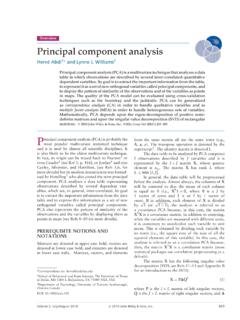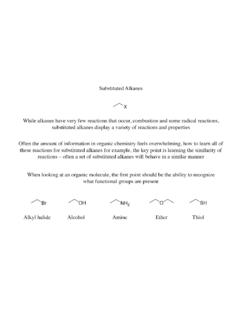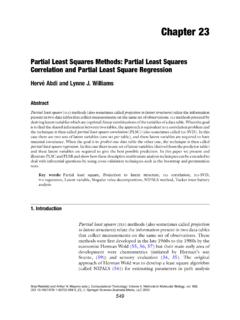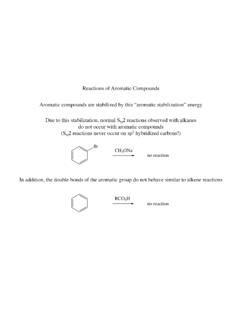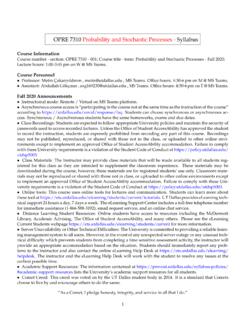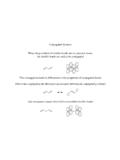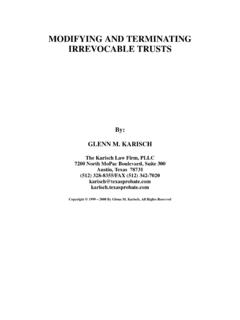Transcription of O O E+ E - University of Texas at Dallas
1 Enols and Enolates A type of reaction with carbonyl compounds is an -substitution (an electrophile adds to the carbon of a carbonyl) OOEE+In the preceding chapters, we primarily studied nucleophiles reacting at the electrophilic carbonyl carbon ONUCOHNUCE nols Enol and a ketone are tautomers OOHU sually the ketone is more stable than the enol and it predominates Under either slightly basic or acidic conditions the concentration of enol can be increased The keto form still predominates With aldehydes there is relatively more enol form than with ketones OOHNaOHBrBrOHBrReactions of Enols The enol form can react with electrophiles A common reaction is
2 Halogenation Under basic conditions it is hard to stop at one addition due to hydrogen abstraction of product is more favored than starting material OOHNaOHBr2 OBrBrBrBrHaloform Reaction This polyhalogenation is exploited with a haloform reaction A methyl ketone will react until three halogens have been substituted on the -carbon OOCBr3 NaOHBr2 With three halogens attached to the carbon, it becomes a good leaving group OCBr3 NaOHOOHCBr3 The three halogens stabilize the negative charge of the leaving group (bromoform)
3 Acid Catalyzed Enol Formation Under acidic conditions, the enol can react with halogen and stop after one addition OOHBrBrOBrH+With acidic conditions, do not form anion adjacent to halogen as in basic mechanism, therefore the reaction can be stopped after one addition Enolizable Positions A consequence of the ability to form enols is that chiral -carbons can racemize Since the -position can form an enol, and the enol is achiral, chiral atoms that are to carbonyls will lose chirality whenever enol formation is favored Bromination of Acids Carboxylic acids can also be brominated First need to convert carboxylic acid into acid halide (labile H would interfere)
4 OOHPBr3, Br2 OBrThis acid bromide can form enol under these conditions, which will react with Br2 OBrOHBrBr2 OBrBrH2 OOOHBrEnolates Enolates are similar to enols but they are far more nucleophilic In order to generate an enolate, need a base to abstract an -hydrogen H3 COCH3pKa of -hydrogens ~20 The -hydrogens are more acidic than normal alkane hydrogens due to electron withdrawing carbonyl group that can delocalize the resultant negative charge OOBase Abstraction Since the pKa of an -hydrogen of a ketone is ~20, the choice of base will determine the extent of enolate formation H3 COCH3H3 COCH2 NaOHBoth water (pKa ~ ) or alcohols (pKa ~16)
5 Are less acidic, therefore with these bases the majority of the compounds will be in the keto form Basicity versus Nucleophilicity Most strong bases are also strong nucleophiles (remember SN2 vs. E2) With carbonyls need to balance two different type of reactions: a strong nucleophile reacting with the carbonyl and a strong base abstracting -hydrogen H3 COCH3 NUCH3 COCH3 NUCH3 COCH3H3 COCH2 BEnolate To generate enolate need to use a base that will not act as a nucleophile Common choice is to use lithium diisopropylamide (LDA) HNNBuLiLiLDA LDA is a strong base (pKa of conjugate is close to 40)
6 , while it is very bulky so it will not react as nucleophile on carbonyl LDA will quantitatively form enolate H3 COCH3H3 COCH2 LDAU sing LDA the enolate will be formed quantitatively, with weaker bases will only form the enolate in a small fraction Enolate as a Nucleophile Have already observed many reactions with a negatively charged nucleophile (most SN2 reactions) An enolate is simply another type of nucleophile, it can react in similar manner as other nucleophiles H3 COCH2E+H3 COCH2 EAlkylation of Enolates One common reaction is to alkylate the enolate H3 COCH2H3 COCH2CH3CH3 BrThis reaction will place an alkyl substituent at the -position of a carbonyl Any electrophile that will react in a SN2 reaction can be used Unsymmetrical Carbonyls With an unsymmetrical carbonyl can obtain two different enolates OLDAOOor OOWhen alkylated in second step.
7 Two enolates generate different products CH3 BrOCH3 BrOHow to obtain one product preferentially? Thermodynamic vs. Kinetic Control The key is the stability of each enolate generated The enolate can be preferentially generated at either site depending upon conditions OLDAOK inetic enolate easier hydrogen to abstract OThermodynamic enolate more stable double bond Lower temperature favors kinetic product Higher temperatures (in this case usually room temperature and above) favors thermodynamic product Product Formation By controlling which enolate is generated, where the -substitution occurs can be controlled O1) LDA, -78 C2) CH3 BrOO1) LDA, RT2)
8 CH3 BrOCannot Alkylate Aldehydes with Enolates Will not obtain -substitution with aldehydes with enolate chemistry The aldehyde carbonyl is too reactive and it will react with the initially formed enolate OHbaseOHOHOOHE nolate acts as nucleophile and carbonyl reacts as electrophile -Alkylation of Aldehydes To alkylate an aldehyde, first need to convert the aldehyde to a less reactive system An imine or imine derivative is used most frequently OHNH2 HNHNLDAHN1) CH3Br2) H+, H2 OOHE namines Another option instead of enolate formation is to form an enamine React carbonyl with 2 amine OHNNCH3 BrNH+, H2 OOThe enamine is not as reactive as an enolate, but it is more reactive than an enol Aldol Condensation Instead of reacting the enolate with an alkyl halide.
9 We can also react the enolate with a carbonyl compound The carbonyl can react as an electrophile OOOOHUpon work-up obtain a -hydroxy ketone Dehydration of Aldol Product The -hydroxy ketone that is formed can also lose water to form an , -unsaturated ketone The loss of water can sometimes occur during work-up, it can be driven to this product through heat and either acidic or basic conditions OOH-H2 OOGreater the conjugation, the easier for loss of water Procedure for Aldol Reaction When reacting in a self-condensation can use an alkoxide base OOOOHOCH3 ONaThe alkoxide base will only deprotonate a small proportion of ketone, but those enolates will react quickly with keto form in an aldol reaction Can drive the reaction to completion Using Different Carbonyl Compounds If there are different carbonyl compounds ( a mixed aldol or crossed aldol)
10 Then conditions need to be considered OOHCH3 ONaOOOOHOOHOOHIf using two different ketones, then four different aldol products will be obtained Options to Control Regioproducts One way to limit the number of products obtained is to use one carbonyl that does not have -hydrogens, therefore there are no hydrogens to abstract and can only react as electrophile CH3 ONaOOHOOHDue to conjugation, product will quickly dehydrate OWant to add compound with -hydrogens (acetone in example shown) slowly to basic benzaldehyde solution Options to Control Regioproducts Another option: if need to use two carbonyls that both contain -hydrogens, need to first generate the enolate quantitatively (strong base) and then add the second carbonyl compound OOHCH3 ONaOOOOHOOHOOHOOLDAOOOHCan obtain high yield of desired aldol product with this method With weak base: With strong base.
